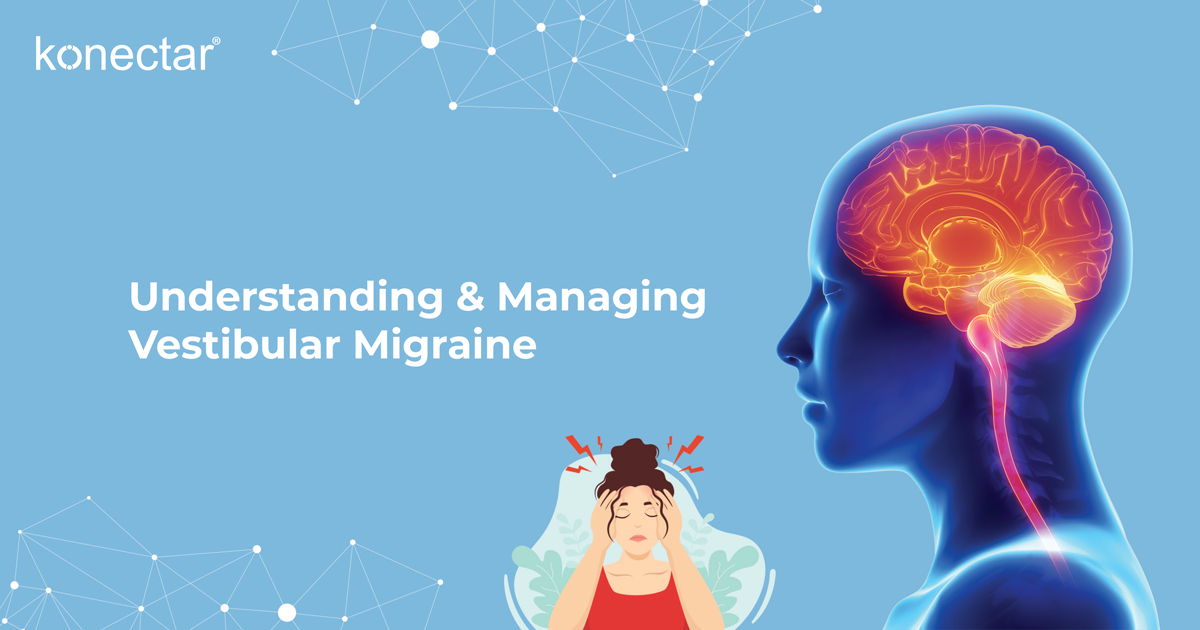Vestibular Migraine which exhibits symptoms similar to migraines affects 1% to 3% of the general population worldwide. Even with the implementation of the international diagnostic criteria, the condition still remains an under-explored facet of neurological health. This highlights the significance of raising awareness about vestibular migraines (VM) and their accurate diagnosis.
What is a Vestibular Migraine?
A vestibular migraine is a neurological condition characterized by recurrent episodes of dizziness and imbalance, commonly called vertigo. It is particularly prevalent in individuals with a history of migraine symptoms. It stands apart from traditional migraines in that a headache is not always a consistent feature. This type of migraine is also referred to as Migraine-associated Vertigo (MAV), Migraine-related Vestibulopathy, and Migrainous Vertigo.
While the causes of vestibular migraines are incompletely understood, it is established that women are more susceptible to this condition than men, with symptoms often intensifying during menstruation. Individuals may encounter VM episodes triggered by various factors, such as disruptions in sleep patterns, exposure to MSG, fluctuations in the menstrual cycle, and the consumption of certain foods like chocolate, aged cheese, and red wine.
Furthermore, it's essential to recognize vestibular migraine as a genetic disorder influenced by both environmental and hormonal factors. While a genetic predisposition is inherited from parents, this condition can be influenced over time by individual habits, hormonal fluctuations, stress levels, and occasionally may emerge spontaneously.

The symptoms of vestibular migraines can seem like traditional migraine headaches, such as a
-
Severe, pulsating headache typically localized to one side of the head.
-
Nausea, vomiting, and heightened sensitivity to light, smell, and noise
-
Additionally, one may experience episodes of vertigo (dizziness) lasting from minutes to hours, sometimes extending to days.
-
Feelings of unsteadiness and a potential loss of balance.
-
Sensitivity to motion is another characteristic feature.
-
Subjective hearing symptoms like ringing, fullness, or pressure in one or both ears are common.
-
Individuals experiencing vestibular migraines may encounter a mix of vestibular attacks, visual aura, and heightened sensitivity to visual stimuli and motion at various intervals. These occurrences may or may not be accompanied by an actual headache.
Diagnosing Vestibular Migraines
Currently, there are no definitive blood or imaging tests to diagnose vestibular migraines. However, the International Headache Society has recently established criteria to aid healthcare professionals in diagnosing this disorder. Vestibular migraines may be indicated if:
-
You have a history of migraines.
-
Episodes last between 5 minutes and 72 hours.
-
Symptoms are moderate to severe, hindering daily tasks or rendering you incapacitated.
-
At least half of the episodes are accompanied by one of these migraine symptoms:
-
A headache with two of these characteristics: one-sided, pulsing, moderate to severe, or worsens with activity
-
Sensitivity to light or sound
-
Visual disturbances like shimmering or flashing lights (migraine aura)
The most effective approach is preventive measures, where one needs to recognize and avoid the triggers. Many cases can be successfully managed through trigger avoidance alone. If avoiding the triggers is insufficient in managing symptoms, then HCPs may prescribe medications to prevent vestibular migraine episodes.
Medications such as a beta-blocker, calcium channel blocker, antidepressant, and/or an anticonvulsant may be prescribed. Antidepressant is usually recommended to stabilize the central nervous system. Medication can be personalized based on individual medical conditions, and once symptoms are under control, doctors may taper off medications.
-
How long does vestibular migraine last?
The duration of vestibular migraines can vary, ranging from brief episodes lasting a few seconds to minutes or even days. However, it is uncommon for these migraines to extend beyond 72 hours.
-
What is the most common trigger of vestibular migraine?
The most common triggers of vestibular migraines can vary among individuals, but stress is often reported as a significant and widespread trigger. Other common triggers include bright lights, lack of sleep, weather changes, dietary factors, visual disturbances, menstrual fluctuations, dietary factors, exercise, and noise.
-
How to treat vestibular migraine?
Avoiding triggers that cause vestibular migraine symptoms remains the effective way to manage this condition. If avoiding the triggers proves insufficient, doctors may prescribe medications based on your existing medical conditions. Vestibular Migraine rehabilitation is also another effective way to manage chronic balance dysfunction associated with the condition.
-
What is a Vestibular Migraine Diet?
A Vestibular Migraine Diet implies avoiding the consumption of foods and beverages that trigger VM symptoms. Studies reveal certain foods and beverages such as chocolate, cheese, nuts, citrus fruits, processed meats, monosodium glutamate (MSG), aspartame, fatty foods, coffee, and alcohol are the potential triggers for vestibular migraines.
The impact of vestibular migraines, particularly chronic ones, can affect an individual's well-being and ability to perform daily tasks. The path to effective management lies in scientific understanding, individualized care, and a proactive approach to recognizing triggers and their avoidance. By embracing this perspective, individuals can navigate the complexities of vestibular migraines with resilience and empowerment.



